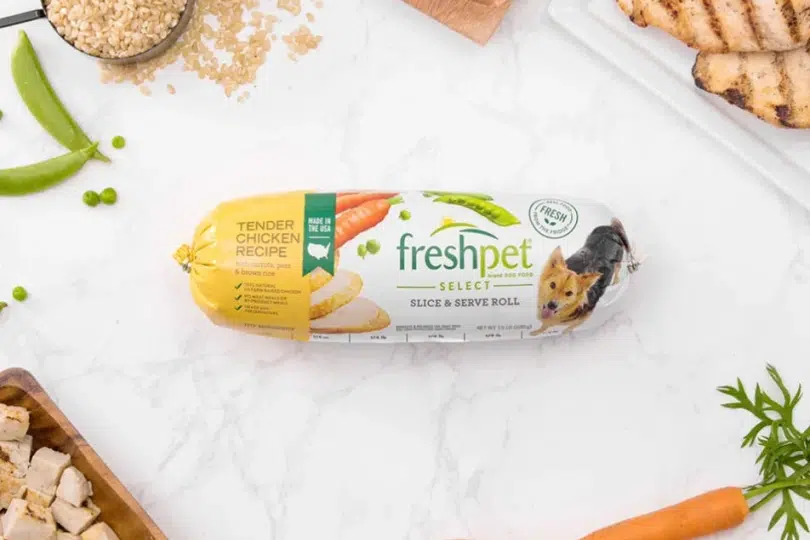As an Amazon Associate, I earn from qualifying purchases
Yes, you can freeze Freshpet dog food. Freezing helps maintain its freshness and nutritional value for longer periods.
Freshpet dog food is a popular choice among pet owners due to its high-quality ingredients and minimal processing. Many pet owners wonder if they can extend its shelf life by freezing. Freezing Freshpet dog food is an effective way to preserve its freshness and nutritional value.
It allows you to buy in bulk and store it without worrying about spoilage. To freeze, simply place the food in airtight containers or freezer bags. Thaw in the refrigerator before serving to ensure your dog enjoys a fresh and healthy meal. This method can save you time and reduce food waste.

Benefits Of Freezing Pet Food
Freezing pet food offers multiple benefits for both pets and owners. This method helps maintain the food’s quality, ensuring your furry friend gets the best nutrition. Discover the benefits of freezing pet food below.
Nutrient Preservation
Freezing locks in essential vitamins and minerals. Fresh pet food retains its nutritional value longer when frozen. This helps maintain a balanced diet for your pet. Lower temperatures slow down nutrient degradation. Frozen food often has more nutrients than refrigerated food.
Extended Shelf Life
Frozen pet food lasts much longer. You can store it for months without losing quality. This saves you time and trips to the store. Extended shelf life also means less food waste. You can buy in bulk and freeze portions.
Convenience
Freezing pet food offers great convenience. You can prepare meals in advance and store them. This makes feeding time quicker and easier. Portioning and freezing food ensures consistent meal sizes. It simplifies meal planning and saves time.
Cost-effectiveness
Bulk buying and freezing pet food can save money. You can take advantage of sales and discounts. Less frequent shopping trips reduce fuel costs. Cost-effectiveness is another benefit of freezing pet food.
Safety
Freezing pet food reduces the risk of bacterial growth. Lower temperatures inhibit bacteria and pathogens. This ensures your pet’s food is safe to eat. Freezing also helps in preserving the food’s texture and flavor.
In summary, the benefits of freezing pet food are numerous. From nutrient preservation to extended shelf life, freezing is a practical option for pet owners.
Types Of Pet Food Suitable For Freezing
Freezing pet food can help maintain its freshness. It also extends its shelf life. Not all pet foods are suitable for freezing. This section explores the types of pet food you can freeze. We will look at wet food, dry food, and homemade meals.
Wet Vs. Dry Food
Wet food is generally more suitable for freezing. It maintains its texture and nutritional value well. Wet food can be frozen in its original packaging or in freezer-safe containers. Always ensure the container is airtight to avoid freezer burn.
Dry food is less commonly frozen. This is because freezing can affect its texture. Dry food can become soggy or lose its crunchiness when thawed. If you choose to freeze dry food, use airtight containers. This helps in maintaining its quality.
| Type of Food | Suitability for Freezing | Storage Tips |
|---|---|---|
| Wet Food | Highly Suitable | Use airtight containers |
| Dry Food | Less Suitable | Use airtight containers |
Homemade Meals
Many pet owners prefer homemade meals for their pets. These meals are often fresh and nutritious. Homemade meals can be frozen for future use. Freezing helps in meal prepping and saves time.
Here are some tips for freezing homemade pet meals:
- Portion the meals into single servings before freezing.
- Use freezer-safe, airtight containers or bags.
- Label each container with the date and type of meal.
- Thaw the meals in the refrigerator before serving.
Freezing homemade meals ensures your pet always has fresh food. It also helps in reducing food waste.
How To Properly Freeze Pet Food
Freezing fresh pet dog food can help keep it nutritious. Proper freezing techniques ensure the food stays fresh and safe. Follow these steps to freeze your pet’s food correctly.
Portion Control
Divide the pet food into serving-sized portions. This makes it easy to thaw only what you need.
- Use a kitchen scale for accurate portions.
- Each portion should be one meal’s worth of food.
Packaging Tips
Packaging the food well prevents freezer burn and keeps it fresh. Follow these tips for best results:
| Method | Description |
|---|---|
| Airtight Containers | Use containers with tight-fitting lids. |
| Freezer Bags | Squeeze out air before sealing. |
| Vacuum Sealing | Best for long-term storage. |
Label each package with the date and type of food. This helps you use the oldest food first.
Thawing Frozen Pet Food
Thawing frozen pet food properly ensures your dog stays healthy. It’s crucial to follow safe thawing methods and avoid contamination.
Safe Thawing Methods
The safest method to thaw pet food is in the refrigerator. Place the frozen food in a container to catch any drips. Let it thaw slowly over 24 hours. This keeps the food at a safe temperature.
In a hurry? Use cold water thawing. Place the frozen food in a sealed plastic bag. Submerge the bag in cold water. Change the water every 30 minutes. Your pet’s food should thaw in a few hours.
The microwave can also be used for thawing. Use the defrost setting. Stir the food midway through to ensure even thawing. Always check for hot spots before serving.
Avoiding Contamination
To avoid contamination, keep raw pet food separate from other foods. Use different cutting boards and utensils.
Wash your hands before and after handling pet food. Clean all surfaces and tools with hot, soapy water.
Store thawed pet food in the refrigerator. Use it within 2-3 days to ensure freshness. Do not refreeze thawed food, as it can spoil.
Monitor your pet’s behavior after eating. Watch for signs of foodborne illness. If you notice anything unusual, consult your vet immediately.
| Method | Time | Instructions |
|---|---|---|
| Refrigerator | 24 hours | Place in container |
| Cold Water | Few hours | Change water every 30 mins |
| Microwave | Minutes | Use defrost setting |
Signs Of Spoiled Pet Food
Understanding the signs of spoiled pet food is crucial for your dog’s health. Fresh pet food can spoil quickly if not stored properly. Knowing these signs helps you keep your pet safe and healthy.
Visual Indicators
Check the food’s appearance. Spoiled pet food often has mold or discoloration. Fresh food should look natural and consistent in color. If you notice any unusual changes, discard the food immediately.
Odor Changes
Trust your nose. Fresh pet food smells pleasant or neutral. Spoiled food has a sour, rotten, or unusual odor. If the smell is off, it’s better to throw the food away.

Best Storage Practices
Freezing fresh pet dog food is a great way to extend its shelf life. Proper storage ensures your dog gets the best nutrition from their meals. Below are some best practices for freezing and storing fresh pet dog food.
Freezer Temperature
Set your freezer to the right temperature for food safety. The ideal temperature for freezing pet food is 0°F (-18°C) or lower. This temperature prevents bacteria growth and keeps the food fresh.
Use a thermometer to check your freezer’s temperature. Adjust the settings if needed to maintain a consistent environment. This step is crucial for preserving the food’s quality and safety.
Labeling And Dating
Always label and date your pet food before freezing. This helps you keep track of how long the food has been stored. Use a permanent marker to write the date and food type on each package.
Below is a simple table for labeling and dating:
| Food Type | Date Frozen |
|---|---|
| Chicken | 01/01/2023 |
| Beef | 01/02/2023 |
| Vegetables | 01/03/2023 |
Follow these tips to maintain the quality and safety of your pet food. Your furry friend deserves the best nutrition possible.
Common Mistakes To Avoid
Freezing Fresh Pet Dog Food can be a great way to preserve its quality and extend its shelf life. However, many pet owners make mistakes that can compromise the food’s safety and nutritional value. Below are some common mistakes to avoid to ensure your dog gets the best meal.
Refreezing Food
One of the most common mistakes is refreezing thawed dog food. This can lead to bacterial growth. Bacteria can multiply when the food is thawed, making it unsafe for your pet. To avoid this, always use the food immediately after thawing. Do not put it back into the freezer.
Consider dividing the food into smaller portions before freezing. This way, you only thaw what you need. Smaller portions also thaw faster, reducing the risk of bacterial contamination.
Ignoring Expiry Dates
Another critical mistake is ignoring expiry dates on the packaging. Expiry dates are there for a reason. They indicate the time frame in which the food is safe to eat. Using expired food can lead to health issues for your pet. Always check the expiry date before freezing the food.
If you can’t use the food before its expiry date, discard it. It is better to waste a little food than to risk your pet’s health. Also, label the food with the freezing date. This helps you keep track of how long the food has been stored.
Here’s a quick reference table to avoid these mistakes:
| Common Mistake | Why It’s Bad | How to Avoid |
|---|---|---|
| Refreezing Food | Leads to bacterial growth | Use food immediately after thawing |
| Ignoring Expiry Dates | Risk of health issues | Check and label expiry dates |
By avoiding these common mistakes, you can ensure your dog enjoys fresh, nutritious meals every time. Pay attention to these details for the well-being of your furry friend.

Frequently Asked Questions
Can You Freeze Fresh Pet Dog Food?
Yes, you can freeze fresh pet dog food. Freezing helps retain nutrients and extends shelf life. Make sure to store it in airtight containers to prevent freezer burn.
How Long Can You Freeze Fresh Pet Food?
You can freeze fresh pet food for up to 6 months. Ensure it’s properly sealed to maintain its quality and nutritional value.
Is Frozen Fresh Pet Food Safe For Dogs?
Yes, frozen fresh pet food is safe for dogs. Freezing preserves its nutrients and prevents bacterial growth, making it a healthy option.
How Do You Defrost Fresh Pet Dog Food?
Defrost fresh pet dog food in the refrigerator overnight. Avoid using microwaves as they can affect the food’s texture and nutrients.
Conclusion
Freezing fresh pet dog food is a practical solution for preserving its quality and nutrients. Ensure proper packaging to prevent freezer burn. Thaw the food safely before serving to maintain its benefits. This method helps in managing food portions and reducing waste, ensuring your pet enjoys fresh meals consistently.
As an Amazon Associate, I earn from qualifying purchases

